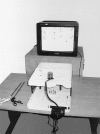Proving the value of simulation in laparoscopic surgery
- PMID: 15319723
- PMCID: PMC1356442
- DOI: 10.1097/01.sla.0000136941.46529.56
Proving the value of simulation in laparoscopic surgery
Abstract
Objective: To assess the McGill Inanimate System for Training and Evaluation of Laparoscopic Skills (MISTELS) physical laparoscopic simulator for construct and predictive validity and for its educational utility.
Summary background data: MISTELS is the physical simulator incorporated by the Society of American Gastrointestinal and Endoscopic Surgeons (SAGES) in their Fundamentals of Laparoscopic Surgery (FLS) program. MISTELS' metrics have been shown to have high interrater and test-retest reliability and to correlate with skill in animal surgery.
Methods: Over 200 surgeons and trainees from 5 countries were assessed using MISTELS in a series of experiments to assess the validity of the system and to evaluate whether practicing MISTELS basic skills (transferring) would result in skill acquisition transferable to complex laparoscopic tasks (suturing).
Results: Face validity was confirmed through questioning 44 experienced laparoscopic surgeons using global rating scales. MISTELS scores increased progressively with increasing laparoscopic experience (n = 215, P < 0.0001), and residents followed over time improved their scores (n = 24, P < 0.0001), evidence of construct validity. Results in the host institution did not differ from 5 beta sites (n = 215, external validity). MISTELS scores correlated with a highly reliable validated intraoperative rating of technical skill during laparoscopic cholecystectomy (n = 19, r = 0.81, P < 0.0004; concurrent validity). Novice laparoscopists were randomized to practice/no practice of the transfer drill for 4 weeks. Improvement in intracorporeal suturing skill was significantly related to practice but not to baseline ability, career goals, or gender (P < 0.001).
Conclusion: MISTELS is a practical and inexpensive inanimate system developed to teach and measure technical skills in laparoscopy. This system is reliable, valid, and a useful educational tool.
Figures



References
-
- Feldman LS, Sherman V, Fried GM. Using simulators to assess laparoscopic competence: ready for widespread use? Surgery. 2004;135:28–42. - PubMed
-
- Fried GM. Simulators for laparoscopic surgery: a coming of age. Asian J Surg. 2004;27:1–3. - PubMed
-
- Derossis AM, Fried GM, Abrahamowicz M, et al. Development of a model for training and evaluation of laparoscopic skills. Am J Surg. 1998;175:482–487. - PubMed
-
- Fried GM, Derossis AM, Bothwell J, et al. Comparison of laparoscopic performance in vivo with performance measured in a laparoscopic simulator. Surg Endosc. 1999;13:1077–1081. - PubMed
Publication types
MeSH terms
LinkOut - more resources
Full Text Sources
Other Literature Sources
Medical

